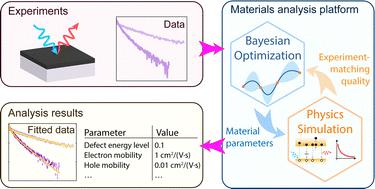当前位置:
X-MOL 学术
›
Energy Environ. Sci.
›
论文详情
Our official English website, www.x-mol.net, welcomes your feedback! (Note: you will need to create a separate account there.)
Physics-based extraction of material parameters from perovskite experiments via Bayesian optimization
Energy & Environmental Science ( IF 32.4 ) Pub Date : 2024-05-29 , DOI: 10.1039/d4ee00911h Hualin Zhan 1 , Viqar Ahmad 1 , Azul Mayon 1 , Grace Dansoa Tabi 1 , Anh Dinh Bui 1 , Zhuofeng Li 1 , Daniel Walter 1 , Hieu Nguyen 1 , Klaus Weber 1 , Thomas White 1 , Kylie Catchpole 1
Energy & Environmental Science ( IF 32.4 ) Pub Date : 2024-05-29 , DOI: 10.1039/d4ee00911h Hualin Zhan 1 , Viqar Ahmad 1 , Azul Mayon 1 , Grace Dansoa Tabi 1 , Anh Dinh Bui 1 , Zhuofeng Li 1 , Daniel Walter 1 , Hieu Nguyen 1 , Klaus Weber 1 , Thomas White 1 , Kylie Catchpole 1
Affiliation

|
The ability to extract material parameters of a perovskite from quantitative experimental analysis is essential for rational design of photovoltaic and optoelectronic applications. However, the difficulty of this analysis increases significantly with the complexity of the theoretical model and the number of material parameters for the perovskite. Here we use Bayesian optimization to develop a flexible, desktop-implementable analysis platform that can extract up to 8 fundamental material parameters of an organometallic perovskite semiconductor from a transient photoluminescence experiment based on a complex full-physics model that includes drift-diffusion of carriers and dynamic defect occupation. An example study of thermal degradation reveals that the carrier mobility and trap-assisted recombination coefficient are reduced noticeably, while the defect energy level remains nearly unchanged. The reduced carrier mobility can dominate the overall effect on thermal degradation of perovskite solar cells by reducing the fill factor, despite the opposite effect of the reduced trap-assisted recombination coefficient on increasing the fill factor. In future, this platform can be conveniently applied to other experiments or to combinations of experiments, accelerating materials discovery and optimization of semiconductor materials for photovoltaics and other applications.
中文翻译:

通过贝叶斯优化从钙钛矿实验中基于物理提取材料参数
从定量实验分析中提取钙钛矿材料参数的能力对于光伏和光电应用的合理设计至关重要。然而,随着钙钛矿理论模型的复杂性和材料参数的数量的增加,这种分析的难度显着增加。在这里,我们使用贝叶斯优化开发了一个灵活的、可在桌面上执行的分析平台,该平台可以从基于复杂的全物理模型的瞬态光致发光实验中提取有机金属钙钛矿半导体的多达 8 个基本材料参数,该模型包括载流子的漂移扩散和动态缺陷占用。热降解的示例研究表明,载流子迁移率和陷阱辅助复合系数显着降低,而缺陷能级几乎保持不变。尽管降低的陷阱辅助复合系数对增加填充因子具有相反的影响,但降低的载流子迁移率可以通过降低填充因子来主导钙钛矿太阳能电池热降解的总体影响。未来,该平台可以方便地应用于其他实验或实验组合,加速光伏和其他应用的材料发现和半导体材料的优化。
更新日期:2024-05-29
中文翻译:

通过贝叶斯优化从钙钛矿实验中基于物理提取材料参数
从定量实验分析中提取钙钛矿材料参数的能力对于光伏和光电应用的合理设计至关重要。然而,随着钙钛矿理论模型的复杂性和材料参数的数量的增加,这种分析的难度显着增加。在这里,我们使用贝叶斯优化开发了一个灵活的、可在桌面上执行的分析平台,该平台可以从基于复杂的全物理模型的瞬态光致发光实验中提取有机金属钙钛矿半导体的多达 8 个基本材料参数,该模型包括载流子的漂移扩散和动态缺陷占用。热降解的示例研究表明,载流子迁移率和陷阱辅助复合系数显着降低,而缺陷能级几乎保持不变。尽管降低的陷阱辅助复合系数对增加填充因子具有相反的影响,但降低的载流子迁移率可以通过降低填充因子来主导钙钛矿太阳能电池热降解的总体影响。未来,该平台可以方便地应用于其他实验或实验组合,加速光伏和其他应用的材料发现和半导体材料的优化。






































 京公网安备 11010802027423号
京公网安备 11010802027423号